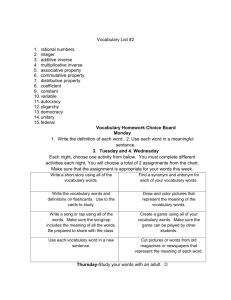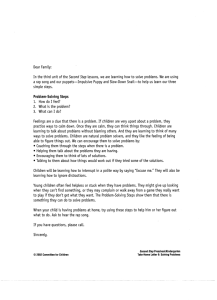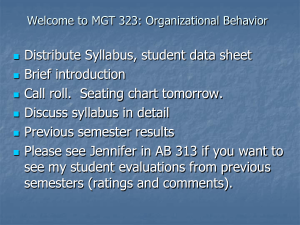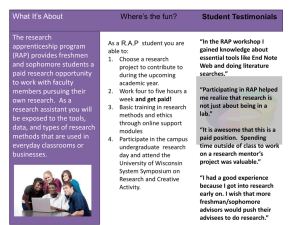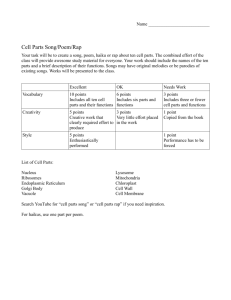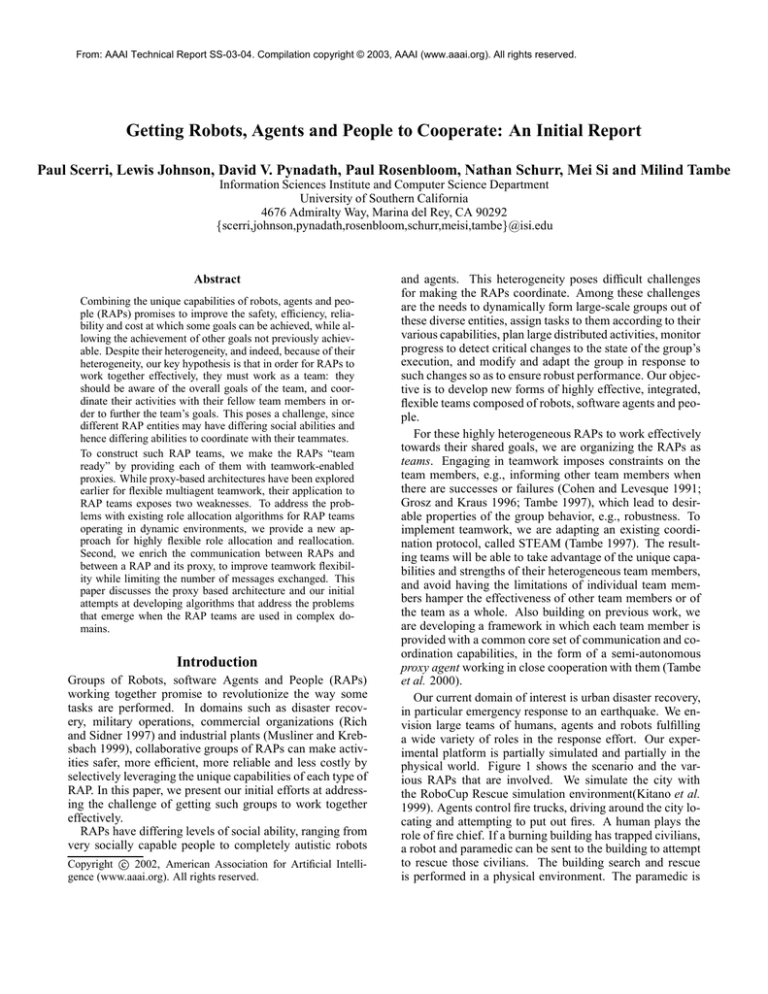
From: AAAI Technical Report SS-03-04. Compilation copyright © 2003, AAAI (www.aaai.org). All rights reserved.
Getting Robots, Agents and People to Cooperate: An Initial Report
Paul Scerri, Lewis Johnson, David V. Pynadath, Paul Rosenbloom, Nathan Schurr, Mei Si and Milind Tambe
Information Sciences Institute and Computer Science Department
University of Southern California
4676 Admiralty Way, Marina del Rey, CA 90292
fscerri,johnson,pynadath,rosenbloom,schurr,meisi,tambeg@isi.edu
Abstract
Combining the unique capabilities of robots, agents and people (RAPs) promises to improve the safety, efficiency, reliability and cost at which some goals can be achieved, while allowing the achievement of other goals not previously achievable. Despite their heterogeneity, and indeed, because of their
heterogeneity, our key hypothesis is that in order for RAPs to
work together effectively, they must work as a team: they
should be aware of the overall goals of the team, and coordinate their activities with their fellow team members in order to further the team’s goals. This poses a challenge, since
different RAP entities may have differing social abilities and
hence differing abilities to coordinate with their teammates.
To construct such RAP teams, we make the RAPs “team
ready” by providing each of them with teamwork-enabled
proxies. While proxy-based architectures have been explored
earlier for flexible multiagent teamwork, their application to
RAP teams exposes two weaknesses. To address the problems with existing role allocation algorithms for RAP teams
operating in dynamic environments, we provide a new approach for highly flexible role allocation and reallocation.
Second, we enrich the communication between RAPs and
between a RAP and its proxy, to improve teamwork flexibility while limiting the number of messages exchanged. This
paper discusses the proxy based architecture and our initial
attempts at developing algorithms that address the problems
that emerge when the RAP teams are used in complex domains.
Introduction
Groups of Robots, software Agents and People (RAPs)
working together promise to revolutionize the way some
tasks are performed. In domains such as disaster recovery, military operations, commercial organizations (Rich
and Sidner 1997) and industrial plants (Musliner and Krebsbach 1999), collaborative groups of RAPs can make activities safer, more efficient, more reliable and less costly by
selectively leveraging the unique capabilities of each type of
RAP. In this paper, we present our initial efforts at addressing the challenge of getting such groups to work together
effectively.
RAPs have differing levels of social ability, ranging from
very socially capable people to completely autistic robots
Copyright c 2002, American Association for Artificial Intelligence (www.aaai.org). All rights reserved.
and agents. This heterogeneity poses difficult challenges
for making the RAPs coordinate. Among these challenges
are the needs to dynamically form large-scale groups out of
these diverse entities, assign tasks to them according to their
various capabilities, plan large distributed activities, monitor
progress to detect critical changes to the state of the group’s
execution, and modify and adapt the group in response to
such changes so as to ensure robust performance. Our objective is to develop new forms of highly effective, integrated,
flexible teams composed of robots, software agents and people.
For these highly heterogeneous RAPs to work effectively
towards their shared goals, we are organizing the RAPs as
teams. Engaging in teamwork imposes constraints on the
team members, e.g., informing other team members when
there are successes or failures (Cohen and Levesque 1991;
Grosz and Kraus 1996; Tambe 1997), which lead to desirable properties of the group behavior, e.g., robustness. To
implement teamwork, we are adapting an existing coordination protocol, called STEAM (Tambe 1997). The resulting teams will be able to take advantage of the unique capabilities and strengths of their heterogeneous team members,
and avoid having the limitations of individual team members hamper the effectiveness of other team members or of
the team as a whole. Also building on previous work, we
are developing a framework in which each team member is
provided with a common core set of communication and coordination capabilities, in the form of a semi-autonomous
proxy agent working in close cooperation with them (Tambe
et al. 2000).
Our current domain of interest is urban disaster recovery,
in particular emergency response to an earthquake. We envision large teams of humans, agents and robots fulfilling
a wide variety of roles in the response effort. Our experimental platform is partially simulated and partially in the
physical world. Figure 1 shows the scenario and the various RAPs that are involved. We simulate the city with
the RoboCup Rescue simulation environment(Kitano et al.
1999). Agents control fire trucks, driving around the city locating and attempting to put out fires. A human plays the
role of fire chief. If a burning building has trapped civilians,
a robot and paramedic can be sent to the building to attempt
to rescue those civilians. The building search and rescue
is performed in a physical environment. The paramedic is
Figure 1: Configuration of experimental platform. Heavy black lines show communication channels between proxies. The
dotted line around the bottom left corner shows the division between what is simulated and what is real.
equipped with an iPaq, on which the proxy runs, and can
communicate with an iPaq on the robot and with the fire
chief. The robot is capable of finding people and leading
them to safety. If it finds injured people, it has a microphone
and speaker which would allow the paramedic to communicate with the injured person. While proxies and teamwork
models deal with some of the key issues in supporting effective heterogeneous teams, scaling up to more complex and
more heterogeneous teams exposes new problems. In this
paper, we look in detail at two specific problems: role allocation and communication; and how these problems have
been addressed.
The first issue we address is how to allocate and reallocate
roles to team members. In earlier versions of our proxies
(Tambe et al. 2000), RAPs would volunteer for roles, with
the first volunteer getting the role. Later, to improve the allocation of roles to RAPs we added a mechanism for the team
to auction off roles. Neither of these mechanisms scale to
larger teams, with many roles in many plans, that we are now
considering. Giving the role to the first volunteer can lead
to a poor assignment of RAPs to roles and auctions are not
feasible for large teams in distributed environments, since
participating in a large number of auctions poses too high
a burden on proxies and communication channels. Other
coordination protocols typically do not have mechanisms
for dynamic role allocation. Even if a coordination mechanism allows role reallocations they are typically considered
only when a RAP has completely failed to perform the role.
This precludes the team from taking advantage of additional
or freed up team members or changing allocations to suit
emerging circumstances. We are now developing a layered
role allocation algorithm that addresses the above problems.
The key idea is to provide multiple mechanisms for role allocation that the proxies and RAPs choose between depending on the circumstances. Each role is initially assigned to
a RAP but can be exchanged or reallocated in a distributed
manner. If distributed role reallocation does not lead to a
good allocation of RAPs to roles, then a group of roles can
be assigned by a single member of the team. These layers
of role allocation allow the team to robustly and quickly find
and maintain an effective assignment of RAPs to roles.
The second issue addressed in this paper is when, how
and what to communicate. There are two types of communication which we consider separately: communication
between RAP/proxy pairs and communication between a
RAP and its proxy. Reasoning about communication between a proxy and its RAP builds on our previous work
on adjustable autonomy (Scerri et al. 2002). In general,
the problem of reasoning about when and what to communicate between RAPs is highly intractable (Pynadath and
Tambe 2002) and approximate solutions are required. While
STEAM communication reasoning has been shown to perform better than communication reasoning in other coordination mechanisms (Pynadath and Tambe 2002), it has two
key limitations. First, STEAM communicates only about
the initiation and termination of team goals. Communication of other information, e.g., information that might help
another RAP complete its role, is not considered but clearly
there are situations where RAPs have information that could
help other RAPs with the performance of their tasks. The
heterogeneity of the RAPs, especially the presence of people, makes the problem of deciding what information to send
even more interesting. Different types of RAPs have different abilities to use information and different abilities to
produce information in a form useful for other RAPs. For
example, an agent that plans routes has likely no need for
information about the context in which that route was requested. People can use far richer context information about
the status of the team to adapt their own behavior to help the
team function more effectively, though care must be taken
not to overwhelm people with information. Conversely, the
amount of information each RAP can provide and the cost
of providing that information varies. For example, robots
are likely to have much less accurate information about their
own context than are people, but people may not be able to
communicate information in a way that a robot can easily
understand. Thus, the heterogeneity of the RAPs leads to a
need for careful reasoning about which information should
be requested from a RAP and where that information is sent.
The second key limitation of STEAM is that it relies on explicit, static specifications of the cost of miscoordination and
the probability of this miscoordination occurring. In complex environments, with potentially many interacting plans,
specification of these costs and probabilities is not feasible.
To address the issues with previous communication reasoning, we are casting the problem of what to communicate as
a decision theoretic planning problem which we solve with
COM-MDPs(Pynadath and Tambe 2002).
RAP Team Architecture
The foundation for creating robust, highly heterogeneous
teams is an architecture that uses semi-autonomous proxy
agents to create an homogeneous coordination layer “above”
the highly heterogeneous RAPs (Tambe et al. 1999). By
providing each RAP with a proxy that has teamwork knowledge we raise the coordination ability of the RAP-proxy pair
to the level at which the rest of the team is operating. Via
the use of adjustable autonomy (Mulsiner and Pell 1999),
the amount of coordination ability that each proxy actually
provides (and the amount which the RAP provides) is dynamically adjusted to the particular context of the RAP at
that point in time. The proxies manage the coordination,
performing the routine operations that are required for cooperation; e.g., informing others when plans are completed,
and assisting in the handling of exceptional situations; e.g.,
finding RAPs to fulfill roles due to failures or overloading.
The proxies can assist in making adjustments to the plan the
group is following, when required. The proxies also perform
more routine tasks, such as information sharing, that ensure
the continued smooth operation of the team, while freeing
the RAP from engaging in these activities. The proxies facilitate the coordination among RAPs, while adjustable autonomy ensures that RAPs can have input into coordination
decisions when required.
Teams of RAP-proxy pairs implement team-oriented programs(TOPs). TOPs are high-level descriptions of the activities to be performed by the team, expressed as abstract
team plans. With team-oriented programming, we specify
the plans that a team may need to perform jointly, and the
inter-dependencies between those plans; but are spared the
effort of specifying all of the coordination and communi-
Figure 2: An example of a proxy based RAP team.
cation. Such programs identify the domain capabilities required to perform each task, which helps in determining how
best to allocate tasks to team members. There may be a small
number of different plans (and sub-plans) to be followed if
a goal is to be achieved under different circumstances. The
proxies execute a plan by allocating relevant plan steps (i.e.,
tasks) to RAPs that will perform the plan steps. The proxies
can make small changes to the plan and dynamically change
assignments of tasks to RAPs to better achieve the goals.
Because the team plan is abstract, the individual RAPs are
free to carry out their assigned tasks as they see fit, based
upon their own domain knowledge and capabilities.
When operating in complex, dynamic and unpredictable
environments the coordination among RAPs must be robust
and ductile. As a mechanism, teamwork provides these characteristics, in part by performing much of the coordination
reasoning online, in reaction to the specific state of the team.
For example, RAPs (or their proxies) decide which plan to
follow depending on the situation and decide what to communicate depending on what they believe other team members know. The flexibility inherent in teamwork has an interesting, useful impact on the reasoning required of each
RAP. Team members are not rigidly coordinated with their
teammates and actively work at staying coordinated. This
reduces the need to perform exactly as a team mate expected
a priori, giving a team member more freedom to perform
their own role as the situation demands. This is especially
important when people are members of the team, since people are very good (relative to agents and robots) at assessing situations and actively flexibly and are also unlikely to
be satisfied performing very rigidly defined roles. To allow
this level of flexibility in the team, we have sometimes used
multiple algorithms for the same coordination problem. For
example, allocation of RAPs to roles can be performed statically at design time, dynamically in a distributed manner
or dynamically in a centralized way. The team chooses between role allocation techniques depending on the circumstances and may even use more than one algorithm for a
single role allocation problem.
Proxies for RAPs
Our proxies are lightweight, domain independent pieces of
software, capable of performing the activities required to
work cooperatively within a larger team on some abstract
Coordination
RAP Interface
State
RAP
Other Proxies
Communication
Adjustable
Autonomy
Figure 3: Proxy software architecture.
team plan(s). Each proxy works closely with a single RAP
and in cooperation with other proxies. A proxy can be
thought of as a kind of a “personal assistant” for the RAP,
acting on behalf of the RAP in the group activities. The
proxy is implemented in Java and is designed to run on a
number of platforms including laptops and hand-held devices.
The proxy software is made up of five components: communication, coordination, state, adjustable autonomy and
RAP interface. Each component in the architecture abstracts
away details allowing other components to work without
considering those details. For example, the RAP interface
component deals with the details of the type of RAP and the
media with which to interact with the RAP, while the coordination component deals with RAPs as abstract entities
having heterogeneous capabilities. The abstraction the component provides for other components is independent of both
the details of its internal reasoning and of the peculiarities
of the components it interacts with. For example, the communication component will be tailored to the medium being
used to communicate, e.g., wireless or wired, but the coordination component will only be told available bandwidth and
cost of communication. Likewise, the adjustable autonomy
component uses the RAP interface component as an abstract
tool for sending and receiving messages from the RAP. It
will know abstract characteristics, like how costly a communication is and the probability the RAP will respond, but
not know whether the RAP interface is inferring responses
from an analysis of a person’s emotional reaction or directly
altering the memory of a robot.
An emerging, unanswered research question is how much
knowledge of both the RAP and the current state of the domain the proxy needs in order to perform its job effectively.
Our current implementation is attempting to minimize the
detailed knowledge used by the proxy, with future testing
aimed at showing whether more knowledge is required.
An Initial Approach to Role Allocation Using
Layers
The role allocation algorithm is responsible for assigning
RAPs to roles within a team plan and reallocating RAPs to
roles when the situation or plans change (Nair et al. 2002).
Given the complex, dynamic environments in which the
RAP teams will act, reallocations of roles in response to failures, difficulties or opportunities will be the norm, rather
than the exception. Our preliminary approach to role allocation and reallocation uses three “layers” of algorithms
in order to maximize flexibility and robustness. First, the
TOP provides an initial allocation of RAPs to roles. This
static allocation does a simple, reasonable allocation. The
initial allocation may be an allocation of a the role to a
particular RAP or it may be a simple “rule” for finding a
RAP, e.g., “The RAP detecting the fulfillment of the plan
pre-condition” or “The physically closest, capable RAP”.
For example, when a role to help an injured patient is triggered by a (human) paramedic finding the patient, a reasonable initial allocation of the role will be to allocate it to the
paramedic. In some domains, this simple static allocation of
roles may all that is required much of the time.
Second, the RAP that is currently allocated to a role can
attempt to find another RAP to perform the role. This distributed role reallocation allows simple switching of roles
to improve performance or recover from failure. For example, if a mobile robot found an injured patient that it
could not help autonomously, it might offer that role to an
available (human) paramedic, perhaps then taking over that
paramedic’s current role of searching another part of the
building. Such role reallocations allow small sub-groups
of RAPs to leverage each others capabilities in an efficient
manner.
Finally, the responsibility for reallocating a role can itself be transferred. This mechanism allows groups of roles
that need to be reallocated to be “centralized” for a more
globally efficient allocation. If the proxies detect that there
are several roles, which the same entities are simultaneously
being asked to perform, they can transfer responsibility for
allocating all roles to some central point. For example, if
several injured patients were found in a short period of time,
the allocation of paramedics to patients could be performed
by a central command center, perhaps minimizing the distance each paramedic needed to travel. After this centralized role reallocation has been performed, further local role
reallocations (i.e., the second type, described above) could
be performed to address small problems with the centralized
allocation. For example, particular paramedics allocated to
particular patients as a part of a larger allocation might find
themselves dealing with a patient for which they do not have
appropriate equipment. By performing a local role reallocation with a nearby paramedic, the injured patients could be
better cared for. The combination of “centralized” role allocation and subsequent “distributed” reallocation reduces
both the need for the central role allocation to know all details and make an optimal allocation and the need to for extensive local negotiations. Thus, each role allocation algorithm complements the other algorithms and provides an additional layer of flexibility to handle a type of role allocation
problem efficiently.
Preliminary Thought on Communication
Algorithms
When a large group of RAPs and proxies attempts to act in
a coordinated manner in a distributed, unpredictable and dynamic environment there is a large volume of information
which there is some use to communicate. However, there
are two important reasons why all this information cannot
and should not be communicated. Most simply, there is too
much information to communicate everything, especially
when there are a large number of RAPs and some are using
relatively low bandwidth communication media. The second, perhaps more interesting reason, is that it is important
not to overwhelm RAPs with information or with requests
for information. Below we describe in more detail the algorithms for inter-RAP communication and RAP-proxy communication and how they balance the desire for information
with the need not to overwhelm communication media or
RAPs.
Inter-RAP Communication
The coordination module makes all of the decisions regarding inter-proxy communication in an attempt to ensure
proper team behavior. It seeks to balance the need to communicate relevant information in a timely manner, against
the need to avoid overburdening the team members with
an overload of messages to process. In general, the problem of choosing the best messages to send and the best
times to send them is NEXP-complete (Pynadath and Tambe
2002). Given this prohibitive complexity, we instead focus on making approximately optimal decisions in a manner
which is computationally feasible within our target domains,
but which still attains reasonable team performance.
Our first step in achieving practical, approximately optimal coordination is to reduce the communication decisions to binary choices on new beliefs. Thus, when a
proxy receives a new piece of information (e.g., from an
observation made by its RAP), it can potentially communicate that information to its teammates; otherwise, it never
communicates the information at all. We thus ignore the
possibility of communicating the information at some later
time, which prevents realization of optimal communication in certain domains (e.g., the example domain of (Pynadath and Tambe 2002)). However, many existing coordination algorithms have found success within this restricted space of immediate communication (Tambe 1997;
Jennings 1995). Furthermore, we gain significant computational savings by so restricting our space (Pynadath and
Tambe 2002). The end result is that our proxy architecture
implements a communication policy that maps a new belief
into a decision on whether to communicate that belief or not.
Unfortunately, existing communication policies produced
by multiagent research will have only limited success in
RAP teams. Many coordination algorithms (e.g., STEAM)
though successfully applied to real-world domains often display inflexibility that can lead to non-negligible degradation in performance in our intended domains. Furthermore,
existing coordination algorithms typically rely on heuristic
rules that may not always apply to RAP domains or on userspecified parameters that may overburden RAP system designers. For example, STEAM requires that the TOP contain team plans for each important piece of information to
communicate, as well as the costs and likelihood of miscoordination of these team plans. For our RAP proxy architecture, we would instead like a policy that can make more
automated decisions on communication of arbitrary beliefs.
Our previous work has identified an algorithm that auto-
matically computes the locally optimal communication policy, and this algorithm was feasible within our original example problem (Pynadath and Tambe 2002). However, this
example domain focused on only one belief to be communicated or not communicated. The locally optimal policy’s
exponential computational requirements will not scale over
the very many beliefs relevant in RAP domains. We instead
need a new communication policy that is more flexible and
automated than existing real-world coordination algorithms,
but whose computational complexity remains acceptable as
the number of beliefs increases in scale.
We have designed our proxy architecture to allow for easy
substitutability of different communication policies, thus
providing a testbed for exploring the space of communication policies within our architecture and examining their
performance within RAP teams. In addition to this empirical evaluation of policies, we will use our COM-MTDP
model to perform analytical evaluations of RAP communication policies, similar to work analyzing existing coordination policies from the literature (Pynadath and Tambe 2002).
The goal of these evaluations is to provide detailed profiles
(perhaps even guarantees) of performance of these policies
within RAP domains.
Furthermore, we plan to exploit knowledge of the team’s
TOP in designing our candidate communication policies. In
particular, the team’s plan hierarchy can provide scoping information that can localize the necessary decision-making
(e.g., certain beliefs may be relevant to only a subset of possible plans). By modeling TOP execution within our COMMTDP framework, we expect to gain unique insight into the
communication requirements of such teams. Given the specialized structure of our TOP, it may even be possible to design a practical communication policy that is optimal within
the architectural assumptions of our TOP semantics.
One of the biggest keys to a successful deployment of
RAP teams will be dealing with the special case of people. People are different from agents and robots in the way
they process information, they can potentially utilize context information better than agents and robots and can often
do better problem solving. However, people also have special limitations, such as limited memory and less aptitude at
things like mathematical calculations. Also, people can get
tired and miss information or process it less well. Things
they can do well when they are fresh they may do poorly
when they are tired or stressed. The workings of the communication algorithm and, especially, the design of the computer interface to the person must be carefully designed to
deal with the peculiarities of people. Two key principles are
guiding the development of the interface between the proxy
and person. First, information should be presented graphically when good spatial metaphors exist for organizing the
information, both to present information compactly and to
exploit the human visual system’s ability to detect patterns.
For example, we superimpose information about fires and
fire trucks onto a plan view display of the the urban area, to
aid the people in reasoning about how to deploy fire trucks
to fight the fires. Secondly, the interface needs to intelligently abstract away details, presenting enough information
to help people make decisions, but not too much to over-
whelm them.
Pre−condition
Fire at X
Fight Fire
Adjustable Autonomy Issues
Adjustable autonomy (AA) reasoning decides whether a
proxy will make a coordination decision autonomously or
whether the decision will be referred to the RAP (Dorais et
al. 1998; Ferguson et al. 1996). For example, AA reasoning
would decide whether the proxy can autonomously accept
(or decline) responsibility for a role on behalf of the RAP or
whether the RAP itself should make that decision.
AA performs two intertwined functions related to providing flexibility in the team. First, AA provides the ability for
the proxy to make coordination decisions on behalf of the
RAP, thus ensuring all RAPs have an ability to make coordination decisions. Because each RAP has an ability to
perform sophisticated coordination reasoning (perhaps only
by relying on its proxy) the team can engage in sophisticated coordination. In the case of a person, AA could assign responsibility to the person for coordination decisions,
to ensure personal preferences, etc. were adequately taken
into account. Notice, that AA does not simply pass all decisions to the RAP if the RAP is capable of making them, but
flexibly chooses between autonomous action and transferring autonomy, depending on the situation and the decision.
Second, the fact that the RAPs can make coordination decisions gives them flexibility to go outside the default coordination of the team for arbitrary and not necessarily predefined reasons. This is important for any RAP that might
have reasons for wanting coordination done in a particular
way. In particular, it allows RAPs to make decisions using information or reasoning capabilities outside the information and capabilities of the proxies. For example, a fire
fighter might have some particular limitation that is not modeled by the proxy that makes her incapable of fighting a particular fire. This capability is especially important for people
who will have far superior reasoning abilities and access to
information than their proxies. In fact, we hypothesize that
people will not be comfortable working in RAP teams unless
they have a large degree of freedom.
Status
To evaluate our RAP teams we are using a mixture of realworld and simulation environments, as described earlier. We
are currently experimenting with scenarios in which a single
human fire chief interacts with up to ten fire trucks (controlled by agents). The fire chief is responsible for assisting
with role allocations and assigning priorities to fires. Currently, the fire fighting plan is relatively simple (see Figure
4), though reasonably effective. In the near term, we are
working on integrating robots and mobile people (with proxies running on hand-held devices) into the scenario.
Conclusion
In this paper, we have presented initial efforts to develop
teams of RAPs that can successfully cooperate on shared
tasks in complex dynamic environments. When we adapted
an approach that used teamwork and proxies two key issues
Post−condition
Fire at X out
3−6 RAP capable of "Fight Fire"
Plan Step
Plan steps should
be performed
by same RAP
None
At fire
Go to fire
Extinguish
At fire X
Fire at X out
RAP capable of extinguish fire
RAP capable of "Move"
Capability specification
for plan step
Figure 4: A sample team plan for a fighting fire.
emerged. Firstly, a new role allocation and reallocation algorithm was needed to more flexibly transfer responsibilities
for roles within a team plan. Our preliminary efforts employ
a layered approach to this role allocation that allows both
static, distributed and centralized allocation mechanisms to
be used, depending on the situation. Second, communication between a large number of highly heterogeneous entities raises the challenging problem of ensuring adequate information is communicated to where it is required. We are
intending to apply sophisticated decision theoretic reasoning
to make situation specific decisions about when and what to
communicate.
Acknowledgments
This research was supported by DARPA award no.F3060201-2-0583. We would like to thank Dylan Schmorrow at
DARPA and Allen Sears at CNRI. We also thank our colleagues, especially, Guarav Sukhatme, Sameera Poduri and
Dennis Wolf.
References
Philip R. Cohen and Hector J. Levesque. Teamwork. Nous,
25(4):487–512, 1991.
G. Dorais, R. Bonasso, D. Kortenkamp, B. Pell, and
D. Schreckenghost. Adjustable autonomy for humancentered autonomous systems on mars. In Proceedings
of the First International Conference of the Mars Society,
pages 397–420, August 1998.
G. Ferguson, J. Allen, and B. Miller. TRAINS-95 : Towards a mixed-initiative planning assistant. In Proceedings
of the Third Conference on Artificial Intelligence Planning
Systems, pages 70–77, May 1996.
Barbara Grosz and Sarit Kraus. Collaborative plans for
complex group actions. Artificial Intelligence, 86:269–358,
1996.
Nick Jennings. Controlling cooperative problem solving in
industrial multi-agent systems using joint intentions. Artificial Intelligence, 75:195–240, 1995.
Hiroaki Kitano, Satoshi Tadokoro, Itsuki Noda, Hitoshi
Matsubara, Tomoichi Takahashi, Atsushi Shinjoh, and
Susumu Shimada. Robocup rescue: Searh and rescue in
large-scale disasters as a domain for autonomous agents
research. In Proc. 1999 IEEE Intl. Conf. on Systems, Man
and Cybernetics, volume VI, pages 739–743, Tokyo, October 1999.
Dave Mulsiner and Barney Pell. Call for papers: AAAI
spring symposium on adjustable autonomy. www.aaai.org,
1999.
D. Musliner and K. Krebsbach. Adjustable autonomy in
procedural control for refineries. In AAAI Spring Symposium on Agents with Adjustable Autonomy, pages 81–87,
Stanford, California, 1999.
R. Nair, T. Ito, M. Tambe, and S. Marsella. Task allocation
in robocup rescue simulation domain. In Proceedings of
the International Symposium on RoboCup, 2002.
David Pynadath and Milind Tambe. Multiagent teamwork:
Analyzing the optimality and complexity of key theories
and models. In First International Joint Conference on Autonomous Agents and Multi-Agent Systems (AAMAS’02),
2002.
C. Rich and C. Sidner. COLLAGEN: When agents collaborate with people. In Proceedings of the International
Conference on Autonomous Agents (Agents’97), 1997.
P. Scerri, D. Pynadath, and M. Tambe. Towards adjustable
autonomy for the real world. Journal of Artificial Intelligence Research, 2002.
Milind Tambe, Wei-Min Shen, Maja Mataric, David Pynadath, Dani Goldberg, Pragnesh Jay Modi, Zhun Qiu, and
Behnam Salemi. Teamwork in cyberspace: using TEAMCORE to make agents team-ready. In AAAI Spring Symposium on agents in cyberspace, 1999.
M. Tambe, D. Pynadath, C. Chauvat, A. Das, and
G. Kaminka. Adaptive agent architectures for heterogeneous team members. In Proceedings of ICMAS’2000,
pages 301–308, 2000.
M. Tambe. Towards flexible teamwork. Journal of Artificial Intelligence Research, 7:83–124, 1997.


